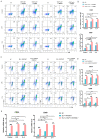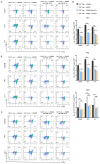BAP31 Knockout in Macrophages Affects CD4+T Cell Activation through Upregulation of MHC Class II Molecule
- PMID: 37686286
- PMCID: PMC10487781
- DOI: 10.3390/ijms241713476
BAP31 Knockout in Macrophages Affects CD4+T Cell Activation through Upregulation of MHC Class II Molecule
Abstract
The differentiation of CD4+T cells is a crucial component of the immune response. The spleen and thymus, as immune organs, are closely associated with the differentiation and development of T cells. Previous studies have suggested that BAP31 may play a role in modulating T cell activation, but the specific impact of BAP31 on T cells through macrophages remains uncertain. In this study, we present evidence that BAP31 macrophage conditional knockout (BAP31-MCKO) mice display an enlarged spleen and thymus, accompanied by activated clustering and disrupted differentiation of CD4+T cells. In vitro co-culture studies were conducted to investigate the impact of BAP31-MCKO on the activation and differentiation of CD4+T cells. The examination of costimulatory molecule expression in BMDMs and RAW 264.7 cells, based on the endoplasmic reticulum function of BAP31, revealed an increase in the expression of antigen presenting molecules, particularly MHC-II molecule, in the absence of BAP31 in BMDMs or RAW264.7 cells. These findings suggest that BAP31 plays a role in the activation and differentiation of CD4+T cells by regulating the MHC class II molecule on macrophages. These results provide further support for the importance of BAP31 in developing interaction between macrophages and CD4+T cells.
Keywords: BAP31; CD4+T cell; MHC-II; activation; differentiation; macrophages.
Conflict of interest statement
The authors declare no conflict of interest.
Figures






Similar articles
-
BAP31 affects macrophage polarization through regulating helper T cells activation.J Mol Histol. 2022 Oct;53(5):843-855. doi: 10.1007/s10735-022-10095-5. Epub 2022 Aug 26. J Mol Histol. 2022. PMID: 36018529
-
SYK regulates macrophage MHC-II expression via activation of autophagy in response to oxidized LDL.Autophagy. 2015;11(5):785-95. doi: 10.1080/15548627.2015.1037061. Autophagy. 2015. PMID: 25946330 Free PMC article.
-
BAP31 is involved in T cell activation through TCR signal pathways.Sci Rep. 2017 Mar 23;7:44809. doi: 10.1038/srep44809. Sci Rep. 2017. PMID: 28333124 Free PMC article.
-
Immune recognition and effector function in subsets of CD4 T cells.Princess Takamatsu Symp. 1988;19:193-208. Princess Takamatsu Symp. 1988. PMID: 2908353 Review.
-
CD4 function in thymocyte differentiation and T cell activation.Philos Trans R Soc Lond B Biol Sci. 1993 Oct 29;342(1299):25-34. doi: 10.1098/rstb.1993.0131. Philos Trans R Soc Lond B Biol Sci. 1993. PMID: 7904343 Review.
Cited by
-
Pan-cancer analysis shows that BCAP31 is a potential prognostic and immunotherapeutic biomarker for multiple cancer types.Front Immunol. 2024 Dec 16;15:1507375. doi: 10.3389/fimmu.2024.1507375. eCollection 2024. Front Immunol. 2024. PMID: 39737177 Free PMC article.
-
Upregulated BAP31 Links to Poor Prognosis and Tumor Immune Microenvironment in Breast Cancer.Int J Mol Sci. 2025 Jun 21;26(13):5975. doi: 10.3390/ijms26135975. Int J Mol Sci. 2025. PMID: 40649753 Free PMC article.
-
The molecular mechanism of on-demand sterol biosynthesis at organelle contact sites.bioRxiv [Preprint]. 2024 May 12:2024.05.09.593285. doi: 10.1101/2024.05.09.593285. bioRxiv. 2024. PMID: 38766039 Free PMC article. Preprint.
-
BAP31 Promotes Adhesion Between Endothelial Cells and Macrophages Through the NF-κB Signaling Pathway in Sepsis.J Inflamm Res. 2024 Feb 26;17:1267-1279. doi: 10.2147/JIR.S448091. eCollection 2024. J Inflamm Res. 2024. PMID: 38434584 Free PMC article.
References
MeSH terms
Substances
Grants and funding
LinkOut - more resources
Full Text Sources
Molecular Biology Databases
Research Materials

